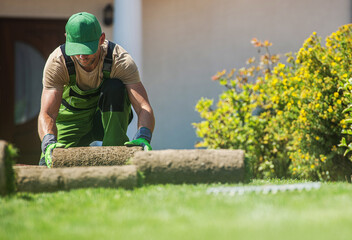Before you begin your turf installation project, you need to prepare the area. Remove any vegetation and other plants that may interfere with the installation. If necessary, use a sod cutter to remove these plants. If you have a lot of vegetation, it may be necessary to dig up a bit of soil to make room for the turf. A few inches of soil should be left at the bottom of the area for the turf to sit properly. Next, it is important to remove any existing grass.

In addition to the right equipment, you also need a carpet stretcher, otherwise known as a knee-kicker. This tool is padded on one end. It is available at home improvement stores. It is also important to have a level surface for the installation to work. If you are installing a new turf, you should hire Artificial Grass installer. This way, you won’t end up with a patchy turf installation.
Another thing to consider is the location. Turf installation should be done in an area where the soil drains well. However, turf installation can be tricky in areas with poorly draining soil. To ensure proper drainage, install a perimeter drainage system. A drainage gap every six inches around the perimeter should be adequate for light rain. Lastly, map the perimeter of the turf area. This will help you distinguish it from other components. You should also fence off the entire area once the turf installation is complete.
Once you’ve surveyed the area, you should prepare the base. This base will help protect your turf from gophers, which dig holes under the turf. The base must also be level. A good base is an important factor for drainage and even surface. A 2% grade is recommended for drainage purposes, as it helps keep water from pooling and causing damage. If you’re concerned about organic growth beneath the surface, you can add a geotextile layer to the base before installing the turf.
When fastening your turf, it’s important to place nails in strategic locations. Make sure to space them evenly so that they don’t dig into the hardscape. It’s also important to place 60D nails every three to four inches along the perimeter and every 12 to 24 inches in the center. Ensure the turf is taut while fastening, and don’t use deep nails that may cause dips in the turf. Also, be sure to spread the blades of the turf so that they don’t get stuck under the nails.
Seams on your turf are a common problem, so you’ll need to apply seam tape to keep it from unraveling. Once the seam tape is on, you can use adhesive to fasten it to the soil. You can also use galvanized stakes or landscaping anchor pins to secure the turf to the ground. Make sure to space them about six to eight inches apart. Don’t over-hammer; too much hammering will cause dips in the lawn.
In some cities, winters can be harsh and summers can be hot. Fortunately, artificial turf can withstand these extreme conditions. Whether you’re planning a soccer game, football practice, or hockey game, the expert staff can provide the solution for you. If you’re interested in an artificial grass field, contact them today to start planning your turf installation. It’s easy and affordable to choose the best solution for your needs. It’s also important to choose the right turf installation company for your location.
An artificial turf is an ideal option for small spaces. It requires little maintenance, but it can heat up in the sun and can be uncomfortable for families with small children and pets. Artificial turf installation differs from the installation of natural grass, so make sure to hire an experienced landscaper for the project. You can save money by completing the project yourself, but it’s also important to remember that it’s a labor-intensive process. You may want to hire a professional for your turf installation if you have limited experience.
You can choose between sod and artificial turf. The former has an instant appeal, but it is not as environmentally friendly as sod. Because sod has a tight root system, it is easier to manage than seeded lawns. However, sod costs more and is more susceptible to disease than a seeded lawn. Hence, sod is more expensive than seeded grass, but is the easiest option for those with limited budgets.
You can also visit our other websites and post your article.
Open Mind Design VT , RCUD More Electric , Lancaster PA Contractors , LC Day Of Caring , TKO Plumbing Co , Colorado Springs Co Roofer , Tavolo App , Computer Medics OFCE , Computer Medics Of Central Wisconsin , Triad Works , Grease Trap Cleaning Houston , Thick Business Band , Digipos-Solutions , Bromleys-Hillhurst , Maritime Bethel At Savannah , The Weekly , Metal Lurg Aluminium , Benton City EDC , SQ Sourcings, R Tech Perrformance , My Money Life , Protect What Com , Population In Perspective , AST Marketing Group Exit Strategy , Future Of Workni , Elliston FD , Ebook Ebook , Kennesaw Landscapes, Fjord Husreivers Reach Of Jackson , The St Petersburg Home Inspector , Loughborough Innovation , Mid South Cleaners , Meadowbrook Farm, Rash Design , Concrete Style, Diamond Landscapes Colorado , New England State Map , Birmingham Best Tree Service